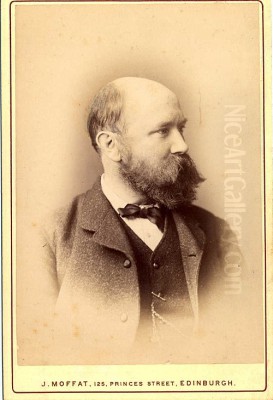
William McTaggart stands as a colossus in the landscape of Scottish art history. A painter whose career spanned the latter half of the nineteenth century and the dawn of the twentieth, he captured the essence of his native land, particularly its dramatic coastlines and the ever-shifting interplay of light, water, and air, with unparalleled vigour and sensitivity. Often hailed as a distinctly Scottish Impressionist, McTaggart forged a unique path, absorbing influences yet developing a deeply personal style that resonated with the spirit of Scotland and anticipated later movements in modern art. His profound connection to the natural world, combined with an empathetic understanding of human life within it, resulted in a body of work that continues to captivate and inspire.
Early Life and Artistic Awakening
Born on October 25, 1835, in the small farming hamlet of Aros, near Campbeltown on the Kintyre Peninsula in western Scotland, William McTaggart's origins were humble. His father was a farmer, and the rugged beauty of the Argyll coast formed the backdrop to his childhood. This early immersion in a landscape dominated by the sea and sky undoubtedly shaped his artistic sensibility from a young age. Though formal education opportunities were limited, his innate talent for drawing became apparent early on.
At the age of twelve, McTaggart was apprenticed to a Dr John Buchanan, an apothecary in Campbeltown. Fortuitously, his employer recognised the boy's artistic inclinations and encouraged them. This period provided McTaggart with the stability and support needed to nurture his burgeoning skills. He began sketching the local scenery and harbour life, developing his observational abilities. Encouragement from friends and perhaps informal guidance, possibly including an introduction to the portrait painter Sir Daniel Macnee who was connected to Campbeltown, further solidified his determination to pursue art seriously. By the age of sixteen, in 1852, he made the pivotal decision to move to Edinburgh, the heart of Scotland's artistic and cultural life, to seek formal training.
Formative Years at the Trustees' Academy
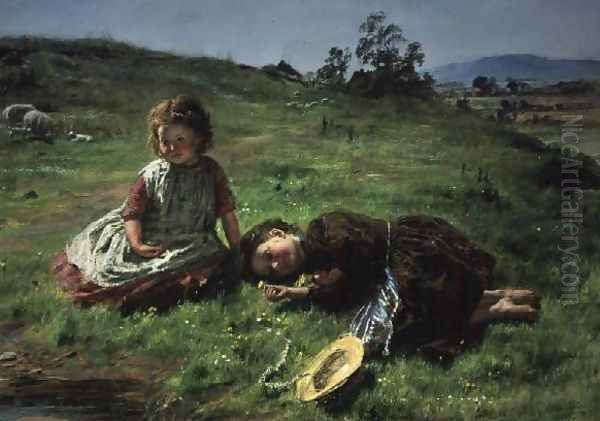
Edinburgh offered McTaggart the structured education he sought. He enrolled at the prestigious Trustees' Academy, the forerunner of the Edinburgh College of Art. This institution was, at the time, under the influential direction of Robert Scott Lauder. Lauder was a gifted teacher who fostered a generation of talented Scottish artists, encouraging individual expression alongside rigorous technical grounding. McTaggart thrived in this environment, proving himself an exceptional student.
During his time at the Academy, McTaggart studied alongside a remarkable group of contemporaries who would also make significant marks on Scottish art. These included George Paul Chalmers, known for his sensitive portraits and atmospheric landscapes; John Pettie, who would gain fame for his historical and dramatic figure paintings and became a lifelong friend of McTaggart; Peter Graham, later celebrated for his evocative Highland landscapes often featuring cattle; and William Quiller Orchardson, who achieved renown for his elegant narrative scenes. The stimulating atmosphere and friendly rivalries within Lauder's circle undoubtedly spurred McTaggart's development. He excelled in his studies, winning several prizes and quickly establishing a reputation for his skill and dedication. He was elected an Associate of the Royal Scottish Academy (ARSA) in 1859, a significant early recognition of his talent.
Early Career and Influences
McTaggart's early professional work, emerging in the late 1850s and early 1860s, reflects some of the prevailing artistic currents of the time, particularly the influence of the Pre-Raphaelite Brotherhood. Works like Spring and Dora (both 1857) show a meticulous attention to detail, bright, clear colours, and a certain narrative or poetic sentiment, possibly influenced by poets like Alfred, Lord Tennyson or the detailed naturalism championed by John Everett Millais. He painted figure subjects, often featuring children, sometimes touching upon themes of rural life and childhood innocence, occasionally hinting at the underlying hardships, as seen in works depicting poignant scenes of young children.
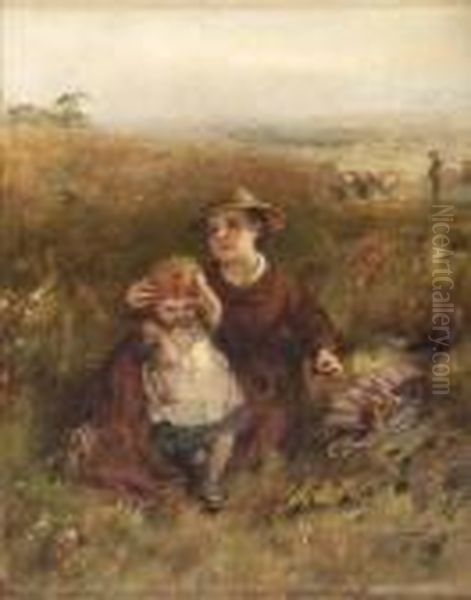
During this period, he also looked towards other masters. There's an affinity in his careful rendering and interest in light effects that suggests an awareness of Dutch Golden Age painters like Johannes Vermeer. The empathetic portrayal of rural life and labour found in the work of French Barbizon school painters, particularly Jean-François Millet, also seems to resonate in some of McTaggart's early figure compositions set within landscapes. He began to establish himself professionally, undertaking portrait commissions to supplement his income while continuing to develop his landscape and genre scenes. In 1863, he married Mary Holmes, establishing a family life that would often feature in his more intimate paintings of children. His first significant marine painting, Hesperus, appeared around 1865, signalling a growing fascination with the sea that would become central to his art. He achieved full membership of the Royal Scottish Academy (RSA) in 1870.
Developing a Unique Vision: The Move Towards Impressionism
The 1870s marked a significant turning point in McTaggart's artistic journey. While aware of developments in France, his evolution towards a looser, more light-filled style appears largely independent, driven by his direct engagement with nature. He increasingly embraced plein air painting – working outdoors directly from the subject. This practice was fundamental to his developing style, allowing him to capture the fleeting effects of weather and light with immediacy. His brushwork became freer and more expressive, his palette brightened, and his focus shifted from detailed rendering to conveying the overall atmosphere and sensation of a scene.
His deep admiration for British landscape masters like John Constable and J.M.W. Turner is evident. From Constable, he likely drew inspiration for his commitment to observing nature directly and capturing the specific conditions of light and weather, particularly the dynamic skies over land and sea. Turner's mastery of atmospheric effects, his dramatic depictions of the sea, and his increasingly abstract handling of paint in later years surely resonated with McTaggart's own explorations of light and elemental forces. While sometimes labelled the "Scottish Impressionist," McTaggart's style differs from his French counterparts like Claude Monet or Camille Pissarro. His work often retains a stronger sense of underlying structure and frequently incorporates narrative or human elements more explicitly than was typical of French Impressionism. His focus remained intensely personal and rooted in his Scottish experience.
Master of Land and Sea
It is in his depictions of the Scottish landscape, and particularly its coastline, that McTaggart's genius truly unfolds. He returned repeatedly to the Kintyre peninsula of his birth, especially the area around Machrihanish Bay, finding endless inspiration in its wide beaches, rolling dunes, and the powerful Atlantic swells. He painted the sea in all its moods: calm and reflective under summer skies, turbulent and menacing under gathering storm clouds, crashing dramatically against rocks, or receding gently at low tide. His ability to capture the movement of water – the transparency of a breaking wave, the spray flung into the air, the wetness of sand – is extraordinary.
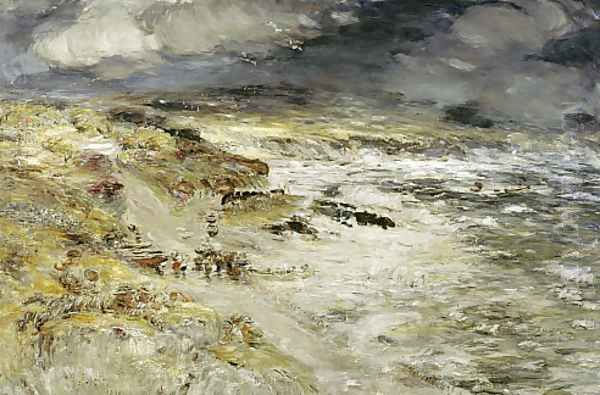
His technique became increasingly bold. He applied paint thickly, often with broad, energetic strokes using both brushes and perhaps palette knives, creating textured surfaces that convey the raw energy of nature. His colours are vibrant and luminous, capturing the unique quality of light in the Scottish Highlands and Islands – often clear and bright, even amidst rain or wind. Children frequently appear in his coastal scenes, playing in the sand, gathering shells, or watching fishing boats. These figures are not mere accessories; they are integral to the scene, embodying innocence and a harmonious connection with the natural world, often serving as focal points that draw the viewer into the vastness of the landscape. His landscapes of the Highlands, while less numerous than his seascapes, similarly convey a deep sense of place and atmosphere.
Themes Beyond Landscape: History and Humanity
While celebrated primarily as a landscape and marine painter, McTaggart's work encompassed broader themes, reflecting his engagement with Scottish history, culture, and social realities. His St Columba series, painted in the late 1890s, depicts episodes from the life of the Irish missionary credited with bringing Christianity to Scotland. These works, while set in recognisable coastal landscapes, engage with national identity and historical narrative, rendered with his characteristic atmospheric power.
Furthermore, McTaggart addressed contemporary social issues, most notably the Highland Clearances and subsequent emigration that profoundly impacted Scottish society. His series of paintings titled Word from the West or similar themes depict families on the shore, often looking out to sea, awaiting news or bidding farewell to loved ones emigrating, usually to North America. These works are imbued with pathos and empathy, capturing the sense of loss, hope, and uncertainty associated with forced migration. They demonstrate McTaggart's ability to infuse his landscapes with deep human feeling and historical resonance, connecting the timeless beauty of the land with the specific experiences of its people. This social awareness adds another layer of depth to his artistic legacy.
Mature Style and Masterworks
In his later career, from the 1880s until his death, McTaggart's style reached its full maturity, becoming increasingly free and expressive, sometimes bordering on abstraction. His focus intensified on capturing the pure sensation of light, air, and movement. Detail became subordinate to overall effect, with forms suggested through dynamic brushwork and vibrant, often non-naturalistic, colour. His application of paint became even more vigorous, building up rich impasto textures that give his canvases a tangible physical presence.
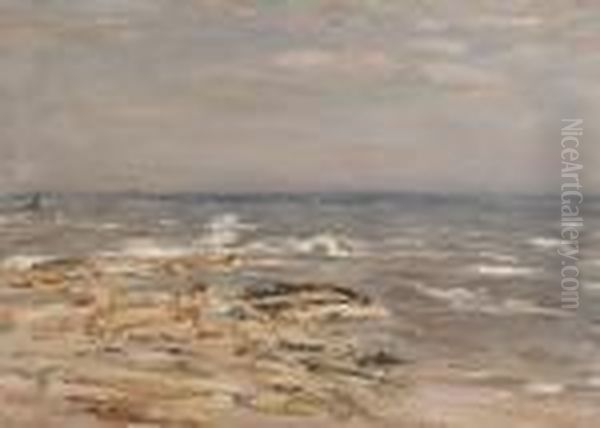
His masterpiece from this period is widely considered to be The Storm (1890), now housed in the National Galleries of Scotland. This large canvas is a powerful evocation of the elemental fury of the sea. Waves crash onto the shore, spray fills the air, and dark clouds dominate the sky, yet there's a sense of exhilarating energy rather than just menace. The figures huddled on the shore are almost overwhelmed by the forces of nature, highlighting McTaggart's recurring theme of humanity's relationship with the powerful environment. Other significant works from this era, like numerous views of Machrihanish Bay or paintings like On the Way Home (1895), showcase his mastery of light, his ability to convey weather conditions, and his deep emotional connection to the Scottish landscape. These late works solidify his reputation as a truly original and forward-looking artist.
Later Life and Family
In 1889, seeking quieter surroundings after the death of his first wife Mary in 1884, McTaggart and his family moved from Edinburgh to Broomiknowe, a village near Lasswade, just south of the city. This remained his home for the rest of his life. He found a congenial companion in his second wife, Marjory Henderson, whom he married in 1886. Marjory was the daughter of the Glasgow painter Joseph Henderson, known for his marine subjects, adding another artistic connection to the family. McTaggart continued to paint prolifically, making annual summer trips back to the Kintyre coast, particularly Machrihanish, to sketch and gather inspiration directly from nature.
His family life remained important, and his children often featured in his work. His artistic inclinations were passed down through generations. Two of his sons, Joseph Henderson McTaggart and Morris Henderson McTaggart, followed in his footsteps and became painters, though they did not achieve the same level of renown. His daughter, Annie Mary, married James Caw, an art historian and critic who later became Director of the National Galleries of Scotland and wrote an important early biography of McTaggart. Furthermore, his grandson, Sir William MacTaggart (1903-1981), became a prominent figure in twentieth-century Scottish art, known for his richly coloured, expressive paintings, and served as President of the Royal Scottish Academy, continuing the family's artistic legacy. William McTaggart passed away at his home in Broomiknowe on April 2, 1910, following a heart attack, leaving behind a vast and influential body of work.
Connections and Contemporaries
Throughout his career, McTaggart maintained connections with fellow artists, though he largely pursued his own distinct path. His formative years under Robert Scott Lauder placed him amidst a talented cohort including John Pettie, George Paul Chalmers, Peter Graham, and William Quiller Orchardson. While their styles diverged, the shared educational background provided a foundation. His early, albeit informal, contact with Sir Daniel Macnee represents another link to the established Scottish art scene.

His influences, as noted, ranged from historical figures like Vermeer and Millet to the great British landscape artists Constable and Turner, and potentially an awareness of French figures like Edgar Degas, particularly regarding capturing movement. While not part of a formal group like the Glasgow Boys (though contemporary with them), his work shares some affinities with their interest in realism and plein air painting. His later expressive style anticipates aspects of the Scottish Colourists, such as S.J. Peploe or F.C.B. Cadell, in its bold handling of paint and vibrant colour, although McTaggart remained fundamentally rooted in landscape and seascape. His legacy clearly impacted later generations, including twentieth-century Scottish artists like William Gillies and William Crozier (leading figures of the Edinburgh School known for their landscape work), and contemporary artists like Will Maclean, who acknowledge his profound influence in depicting the Scottish coast and its relationship with human life. His father-in-law, Joseph Henderson, and grandson, Sir William MacTaggart, represent direct familial artistic connections.
Art Historical Significance and Legacy
William McTaggart occupies a pivotal position in Scottish art history. He is widely regarded as Scotland's foremost marine painter and one of its greatest landscape artists overall. His unique achievement was to forge a modern style deeply rooted in the Scottish environment, independent of, yet parallel to, developments like French Impressionism. He successfully translated the specific atmospheric conditions, the quality of light, and the raw energy of the Scottish land and sea into a powerful and expressive painterly language.
His commitment to plein air painting and his focus on capturing transient effects of light and weather mark him as a key figure in the move towards modernism in Scottish art. He effectively bridged the gap between nineteenth-century Romanticism and Realism and the more expressive, colour-focused concerns of the twentieth century. His influence on subsequent generations of Scottish painters has been significant and enduring, particularly those drawn to landscape and the sea. Artists continue to look to McTaggart for his technical mastery, his emotional depth, and his authentic portrayal of the Scottish spirit. His works are prominently displayed in the National Galleries of Scotland and other major collections, ensuring his continued visibility and appreciation. While perhaps less known internationally than some contemporaries, within Scotland, his stature is immense and undisputed.
Conclusion
William McTaggart's art is a vibrant celebration of the natural world, particularly the dynamic coastal environment of his native Scotland. From his early, detailed works to his mature, expressive, and light-filled canvases, he consistently demonstrated a profound connection to his subjects. He captured not just the appearance of the landscape, but its feeling, its energy, and its relationship to the human lives lived within it. As a master of light and sea, an empathetic chronicler of Scottish life and history, and a pioneer of a distinctly Scottish modernism, McTaggart's contribution to art is both unique and enduring. His paintings remain powerful testaments to the beauty and drama of nature, rendered with a passion and skill that continue to resonate deeply with viewers today.